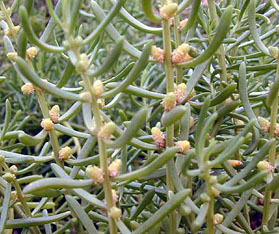Saltwort
Batis maritima
Saltwort is also called beachwort. Another name is glasswort which is also used for Salcornia virginica, (pickleweed). Saltwort plants are perennial halophytes that can also grow in fresh water. On California’s coast they are often found in company with pickleweed, and cordgrass (Spartina foliosa).

Male saltwort plant. Credit: M.Charter. Used with permission.
SPECIES IN DETAIL
Saltwort
Batis maritima
CONSERVATION STATUS: Safe for Now
CLIMATE CHANGE: Not Applicable
At the Aquarium
Our plants, located in the Shorebird Sanctuary, were donated by the Stewards of the Los Cerritos Wetlands located in Long Beach, California.
Geographic Distribution
California to northern South America, West Indies, Galapagos Islands, and southeast United States. Introduced in Hawaiian Islands where it is an invasive species.
Habitat
Saltwort grows in low laying areas of salt marshes, upper edges of tidal flats, at the edge of mangrove stands, and between scattered mangroves where the soil is usually sandy or gravelly.
Physical Characteristics
Saltwort is a low, sprawling, evergreen shrub with bunches of succulent grayish stems. It often grows in thick patches. Narrow, fleshy, lemon-green leaves that keep their color all year are attached to creeping stems. They often have recurved edges that give them a tuber-like appearance. Tiny, white flowers grow on separate male or female plants. The plant produces a multiple of yellow-green, fleshy, berry-like fruits that have a rough texture.
Size
These plants are about 2.54 cm (1 in) long.
Diet
The source of their nutrients is by photosynthesis.
Reproduction
Little is known about seed production and germination of this saltwort species.
The most effective reproduction process appears to be asexual vegetative sprouting from the root crown. Male and female plants are separate. Plants bloom from July to October with seeds dropping off in late summer. The seeds are carried by the tides to new places to sprout.
Adaptation
These succulent plants are salt accumulators. They store salt in vacuoles in their cells and eventually shed their leaves when the vacuoles are full.
Batis maritima will also grow in soils without salts but in these areas the plants are vulnerable to competition from other non-halophyte species. Although not an aquatic plant, saltwort can endure brief flooding and long periods of waterlogged soil.
Conservation
Saltwort is a major colonizer of areas where mangroves have been destroyed by hurricanes. The major benefit of these plants is that they will grow in covers and protect low-laying areas where few other species will grow. .
This species is also important as hosts of the great southern white butterflies, (Ascia monuste), and western pygmy blue butterflies, (Brephidium exilis). Adult female pygmy blues lay their blue-green eggs on the leaves and southern whites lay yellow eggs. The caterpillars of both species eat the leaves, flowers, and seeds while adults dine on the nectar of the flowers.
Special Notes
Saltwort plants are believed to have been carried to the Galapagos Islands from South America when torrential rains washed whole plants out to sea. Today the plants are an important food source for the Galapagos marine iguana.
SPECIES IN DETAIL | Print full entry
Saltwort
Batis maritima
CONSERVATION STATUS: Safe for Now
CLIMATE CHANGE: Not Applicable
Our plants, located in the Shorebird Sanctuary, were donated by the Stewards of the Los Cerritos Wetlands located in Long Beach, California.
California to northern South America, West Indies, Galapagos Islands, and southeast United States. Introduced in Hawaiian Islands where it is an invasive species.
Saltwort grows in low laying areas of salt marshes, upper edges of tidal flats, at the edge of mangrove stands, and between scattered mangroves where the soil is usually sandy or gravelly.
Saltwort is a low, sprawling, evergreen shrub with bunches of succulent grayish stems. It often grows in thick patches. Narrow, fleshy, lemon-green leaves that keep their color all year are attached to creeping stems. They often have recurved edges that give them a tuber-like appearance. Tiny, white flowers grow on separate male or female plants. The plant produces a multiple of yellow-green, fleshy, berry-like fruits that have a rough texture.
These plants are about 2.54 cm (1 in) long.
The source of their nutrients is by photosynthesis.
Little is known about seed production and germination of this saltwort species.
The most effective reproduction process appears to be asexual vegetative sprouting from the root crown. Male and female plants are separate. Plants bloom from July to October with seeds dropping off in late summer. The seeds are carried by the tides to new places to sprout.
These succulent plants are salt accumulators. They store salt in vacuoles in their cells and eventually shed their leaves when the vacuoles are full.
Batis maritima will also grow in soils without salts but in these areas the plants are vulnerable to competition from other non-halophyte species. Although not an aquatic plant, saltwort can endure brief flooding and long periods of waterlogged soil.
Saltwort is a major colonizer of areas where mangroves have been destroyed by hurricanes. The major benefit of these plants is that they will grow in covers and protect low-laying areas where few other species will grow. .
This species is also important as hosts of the great southern white butterflies, (Ascia monuste), and western pygmy blue butterflies, (Brephidium exilis). Adult female pygmy blues lay their blue-green eggs on the leaves and southern whites lay yellow eggs. The caterpillars of both species eat the leaves, flowers, and seeds while adults dine on the nectar of the flowers.
Saltwort plants are believed to have been carried to the Galapagos Islands from South America when torrential rains washed whole plants out to sea. Today the plants are an important food source for the Galapagos marine iguana.

